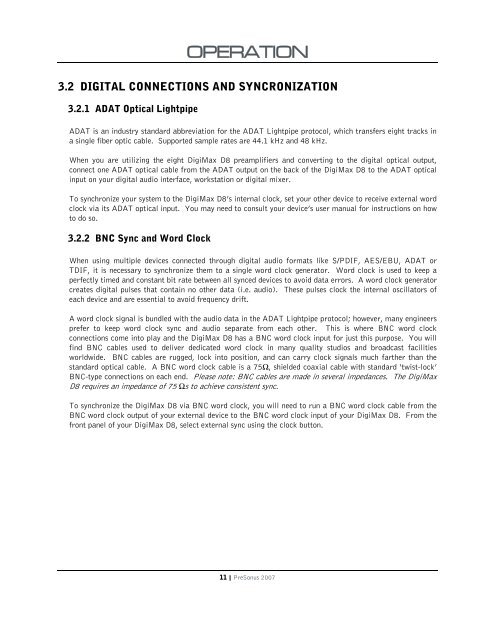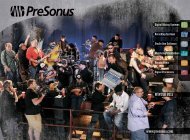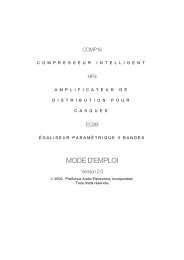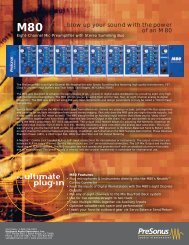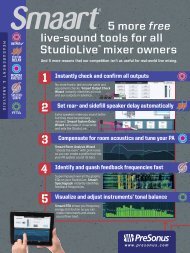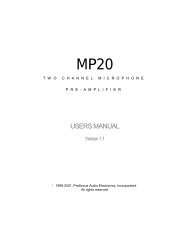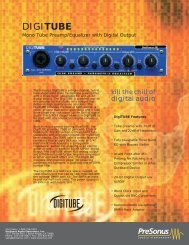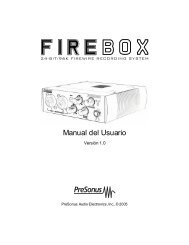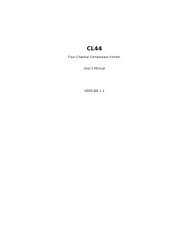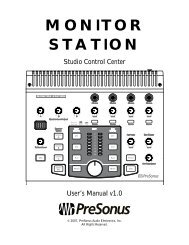Presonus Digimax D8 Manual - zZounds.com
Presonus Digimax D8 Manual - zZounds.com
Presonus Digimax D8 Manual - zZounds.com
You also want an ePaper? Increase the reach of your titles
YUMPU automatically turns print PDFs into web optimized ePapers that Google loves.
OPERATION<br />
3.2 DIGITAL CONNECTIONS AND SYNCRONIZATION<br />
3.2.1 ADAT Optical Lightpipe<br />
ADAT is an industry standard abbreviation for the ADAT Lightpipe protocol, which transfers eight tracks in<br />
a single fiber optic cable. Supported sample rates are 44.1 kHz and 48 kHz.<br />
When you are utilizing the eight DigiMax <strong>D8</strong> preamplifiers and converting to the digital optical output,<br />
connect one ADAT optical cable from the ADAT output on the back of the DigiMax <strong>D8</strong> to the ADAT optical<br />
input on your digital audio interface, workstation or digital mixer.<br />
To synchronize your system to the DigiMax <strong>D8</strong>’s internal clock, set your other device to receive external word<br />
clock via its ADAT optical input. You may need to consult your device’s user manual for instructions on how<br />
to do so.<br />
3.2.2 BNC Sync and Word Clock<br />
When using multiple devices connected through digital audio formats like S/PDIF, AES/EBU, ADAT or<br />
TDIF, it is necessary to synchronize them to a single word clock generator. Word clock is used to keep a<br />
perfectly timed and constant bit rate between all synced devices to avoid data errors. A word clock generator<br />
creates digital pulses that contain no other data (i.e. audio). These pulses clock the internal oscillators of<br />
each device and are essential to avoid frequency drift.<br />
A word clock signal is bundled with the audio data in the ADAT Lightpipe protocol; however, many engineers<br />
prefer to keep word clock sync and audio separate from each other. This is where BNC word clock<br />
connections <strong>com</strong>e into play and the DigiMax <strong>D8</strong> has a BNC word clock input for just this purpose. You will<br />
find BNC cables used to deliver dedicated word clock in many quality studios and broadcast facilities<br />
worldwide. BNC cables are rugged, lock into position, and can carry clock signals much farther than the<br />
standard optical cable. A BNC word clock cable is a 75Ω, shielded coaxial cable with standard ‘twist-lock’<br />
BNC-type connections on each end. Please note: BNC cables are made in several impedances. The DigiMax<br />
<strong>D8</strong> requires an impedance of 75 Ωs to achieve consistent sync.<br />
To synchronize the DigiMax <strong>D8</strong> via BNC word clock, you will need to run a BNC word clock cable from the<br />
BNC word clock output of your external device to the BNC word clock input of your DigiMax <strong>D8</strong>. From the<br />
front panel of your DigiMax <strong>D8</strong>, select external sync using the clock button.<br />
11 | PreSonus 2007


